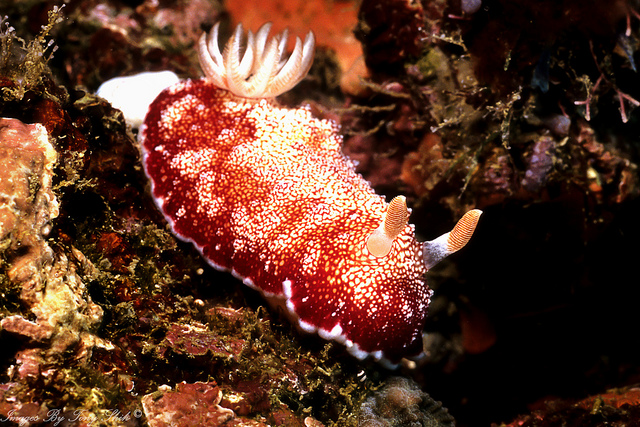Habitat
The Chromodoris reticulata is a sea-dwelling animal. It can be
found primarily living in and around coral reefs, in
sub-tropical
and tropical waters (Wilson, 2002). For previous observations and
experiments, many scientists derive their specimens around the coast
of Japan (Sekizawa, et.al. 2013). The sea slugs live as members of
the coral reef, cohabiting the sea with their sponge prey (Wilson,
2002). Another coral-dwelling animal is the
Hippocampus bargibanti; a sea-horse with bright colors
similar to the Chromodoris reticulata.

Coral reefs need very specific conditions to be in place for their
survival. The water that the coral is living in has to be saline,
clear, and warm (Kleypas, et al. 1999). There has to be an adequate
amount of light available to the reef, and outside forces such as
incoming waves or currents can cause disturbances in the growth of
coral (Kleypas, et al. 1999). Nutrients such as NO₃ and PO₄ need to
be readily available for the coral to thrive as well (Kleypas,
McManus, and Menez 1999).
The light availability that is needed tells us that the reefs need
to be towards the surface of the water to be able to obtain the suns
rays. Since the temperature needs to be warm for the coral, we can
determine most of our corals are closer to the equator, because it
is warmest there. Corals mainly grow off the coast of land located
around the equator. Large masses of the Chromodoris reticulata are
found in correlation with the pattern of coral reef locations,
primarily off the coasts of Australia, Japan, and Africa (Wilson,
2002). Read about a crazy "brain" coral that can be found growing in
a coral reef
here. A coral reef acts as a barrier between the harsh sea and the
land (Molberg and Folke 1999). It also proves as a dominating ground
for breeding and nursing among species such as the Chromodoris
reticulata, because of the protection and species diversity it
offers (Molberg and Folke 1999). There are four main regions where
coral can be found; Indo-West Pacific (IWP), Eastern Pacific (EP),
Western Atlantic (WA), and the Eastern Atlantic (EA) (Molberg and
Folke 1999). Temperature, salinity, light, nutrients, and wave
pressure all change when moving closer or farther away from shore.
For example, farther out from the shore the water becomes colder,
light is less accessible, and so the conditions for coral to grow
becomes harder, if not impossible.
 Figure 1. Map depicting regions of the world where coral reef is
found
Figure 1. Map depicting regions of the world where coral reef is
found
The Chromodoris reticulata is dependent on the safe, and protective
conditions of the coral reef to survive. It is also where the sea
slug’s prey is most plentiful (Be specific) (Wilson, 2002). Since
this is a sea-dwelling animal, you will not find the organism out of
water. You will also not find them in freshwater locations, as they
live in the saltwater bodies. By living in conjunction with coral
reefs, there are some risks involved. If the coral reef dies off,
the sea slug has no where to live. This is a rising concern as coral
reefs are becoming more and more endangered.
There are many organisms that can be found in the coral reef
living with the Chromodoris reticulata, such as the clown
fish, . There are over 300
Chromodorid nudibranch species alone (Turner and Wilson 2008), which
creates a wide variety. Many of these are found living alongside the
Chromodoris reticulata, cohabitating under one reef. The sea slugs
tend to stick near the hard, colorful stones under the sea level of
the beaches near the reef (Eliot 1911). Another organism found close
to the surface is the
Pseudosqullia ciliata. In some areas, the stones
match with the colorful nudibranchia to offer some camouflage (Eliot
1911). In other areas, the slugs vibrant colors stick out, and serve
as a warning towards other species (Eliot 1911).
Return to Home Page
Go to Form and Function